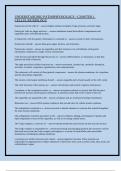UNDERSTANDING PATHOPHYSIOLOGY / CHAPTER 1
CELLULAR BIOLOGY
Eukaryotes are the cells of : - answer-higher animals and plants, fungi, protozoa, and most algae.
Eukaryotic cells are larger and have : - answer-membrane bound intracellular compartments and
organelles and a well-defined nucleus.
In Eukaryotic cells the genetic information is contained in: - answer-several or many chromosomes.
Prokaryotes include: - answer-blue-green algae, bacteria, and rickettsiae.
Prokaryotes contain: - answer-no organelles and their nucleus is not well defined, with genetic
information contained in a single circular chromosome.
Cells become specialized through the process of: - answer-differentiation, or maturation, so that they
perform one kind of function.
The eight specialized cellular functions are: - answer-movement, conductivity, metabolic absorption,
secretion, excretion, respiration, reproduction, and communication.
The eukaryotic cell consists of three general components: - answer-the plasma membrane, the cytoplasm,
and the intracellular organelles.
The nucleus is the largest membrane-bound : - answer-organelle and is found usually in the cell's center.
The chief functions of the nucleus are: - answer-Cell division and control of genetic information.
Cytoplasm, or the cytoplasmic matrix, is: - answer-an aqueous solution or cytosol, that fills the space
between the nucleus and the plasma membrane. It represents about half of the volume of the cell.
The organelles are suspended in the: - answer-cytoplasm and are enclosed in biologic membranes.
Ribosomes are: - answer-RNA-protein complexes that provide sites for cellular protein synthesis.
The endoplasmic reticulum is a - answer-network of tubular channels or cisternae that extend throughout
the outer nuclear membrane.
The endoplasmic reticulum specializes in the: - answer-synthesis, folding, and transport of protein and
lipid components of most of the organelles, as well as in sensing cellular stress.
The Golgi complex is a network of: - answer-smooth membranes and vesicles located near the nucleus.
The Golgi complex is responsible for: - answer-processing and packaging proteins into secretory vesicles
that break away from the Golgi complex and migrate to a variety of intracellular and extracellular
destinations, including the plasma membrane.
Lysosomes are saclike structures that contain: - answer-digestive enzymes. These enzymes are
responsible for digesting most cellular substances to their basic form, such as amino acids, fatty acids, and
carbohydrates /sugars.
, Cellular injury leads to a release of the: - answer-lysosomal enzymes, causing cellular self-digestion.
They also serve as signaling hubs in a network for cellular adaptation.
Peroxisomes appear similar to lysosomes but contain: - answer-several enzymes that either produce or use
hydrogen peroxide and their reactions detoxify waste products.
Mitochondria contain the : - answer-metabolic machinery necessary for cellular energy metabolism. The
enzymes of the respiratory chain /electron-transport chain, found in the inner membrane of the
mitochondria, generate most of the cell's ATP.
The cytoskeleton is the: - answer-"bone and muscle" of the cell and create the skeleton and action sites for
transportation.
The internal skeleton of the cytoskeleton is: - answer-composed of a network of protein filaments,
including microtubules and actin filaments /microfilaments. They also form cell extensions such as
microvilli, cilia, flagella.
The plasma membrane encloses the cell and: - answer-by controlling the movement of substances across
it, exerts a powerful influence on metabolic pathways.
Other important functions of the plasma membrane are: - answer-cell-to-cell recognition, cellular
mobility, and maintenance of cellular shape.
The basic structure of plasma membrane is the - answer-lipid bilayer, which is studded with various
proteins.
Carbohydrates contained within the plasma membrane are generally bound to : - answer-membrane
proteins ,glycoproteins, and lipids or glycolipids.
The lipid bilayer determines the structure of the: - answer-membrane. Each lipid molecule is polar, or
amphipathic: the head is hydrophilic or "water loving" and the tail is hydrophobic or "water hating").
The lipid bilayer membrane is organized in two layers, with the: - answer-tails inward and the heads
outward. This provides a barrier to the diffusion of hydrophilic substances, while allowing lipid-soluble
molecules to diffuse through readily.
Membrane proteins can extend across: - answer-the bilayer, be in the bilayer but primarily on one side or
the other, or can exist outside of the bilayer.
Membrane proteins, like other proteins, are synthesized by: - answer-the ribosome and then translocate,
called trafficking, to different locations in the cell.
Trafficking places unique demands on membrane proteins for: - answer-folding, translocation, and
stability. Misfolded proteins are emerging as an important cause of disease.
Proteins determine the functions : - answer-of the membrane. Proteins perform most of the plasma
membrane's tasks.




